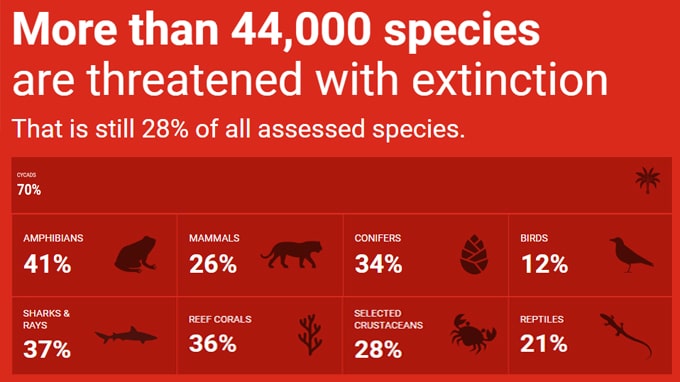 On 11th December 2023, The International Union for Conservation of Nature (IUCN) released the updated IUCN Red List of Threatened Species during the 28th Conference of the Parties(COP 28) of the United Nations Framework Convention on Climate Change (UNFCCC) at Dubai, the United Arab Emirates(UAE).
On 11th December 2023, The International Union for Conservation of Nature (IUCN) released the updated IUCN Red List of Threatened Species during the 28th Conference of the Parties(COP 28) of the United Nations Framework Convention on Climate Change (UNFCCC) at Dubai, the United Arab Emirates(UAE).
- The updated IUCN list includes 157,190 species, of which 44,016 are threatened with extinction.
- This also completes the first comprehensive assessment of the world’s freshwater fish species, which states around 25% (3,086 out of 14,898 assessed species) are at risk of extinction.
Key Points:
i.The updated IUCN list highlights the impact of climate change on biodiversity which affects a majority of species across the globe.
ii.The assessment highlights the impact of threats such as rising sea levels causing seawater to move up rivers, shifting seasons, pollution, invasive species, dams, overfishing and disease.
State of the world’s freshwater fish species:
i.At least 17% of threatened freshwater fish species are affected by climate change, including decreasing water levels, rising sea levels, and shifting seasons.
ii.Threats that affects the freshwater fish species at risk of extinction includes pollution(57%); dams and water extraction(45%), overfishing (25%) and invasive species and disease (33%).
Changes in Red List Status:
| Species | Change in Status |
|---|---|
| Lake Turkana robber (Brycinus ferox) | Least Concern to Vulnerable |
| Atlantic salmon (Salmo salar) | Least Concern to Near Threatened |
| Green turtle (Chelonia mydas) Central South Pacific | Endangered to extinction |
| Green turtle (Chelonia mydas) East Pacific | Vulnerable to extinction |
| Scimitar-horned oryx (Oryx dammah) | Extinct in the Wild to Endangered |
| saiga antelope (Saiga tatarica), | Critically Endangered to Near Threatened. |
| Big-leaf mahogany (Swietenia macrophylla) | Vulnerable to Endangered |
About IUCN Red List:
IUCN’s Red List of Threatened Species, established in 1964, is the world’s most comprehensive information source on the global conservation status of animals, fungi, and plants.
- This is a indicator of the health of the world’s biodiversity.
It classifies species into 9 categories: Not Evaluated, Data Deficient, Least Concern, Near Threatened, Vulnerable, Endangered, Critically Endangered, Extinct in the Wild and Extinct.
Recent Related News:
i.Researchers from MIT-World Peace University (MIT-WPU) in Pune (Maharashtra) have discovered Protosticta Armageddonia (Armageddon Reedtail), a new species of damselfly in the southern Western Ghats of Kerala.
ii.Scientists have discovered a species of Badis fish (fresh water fish), “Badis limaakumi”, from the Milak River in the Mokokchung district of Nagaland. The new species is named after Limaakum, assistant professor and head of the zoology department at Fazl Ali College, Nagaland.
About International Union for Conservation of Nature(IUCN):
Director General– Dr Grethel Aguilar
President– Razan Al Mubarak
Headquarters– Gland, Switzerland
Establishment– 1948




